And so, a little later than planned, due to the lockdown and Corona virus scare, I come to my review of another major science fiction property of the last year or so – the ‘revival’ of Star Trek, most recently in the form of Picard, a ten episode miniseries headed by author/screenwriter Michael Chabon, aided by Alex Kurtzman and Star Trek novelist Una McCormick. This comes a little on from the climax of the second season of Star Trek: Discovery, the rather controversial prequel/side series, starring Sonequa-Martin Green, and recently, Anson Mount. Picard will be our main focus, though, with a selection of images, mainly obtained from the excellent Ex Astris Scientia.org fan website.
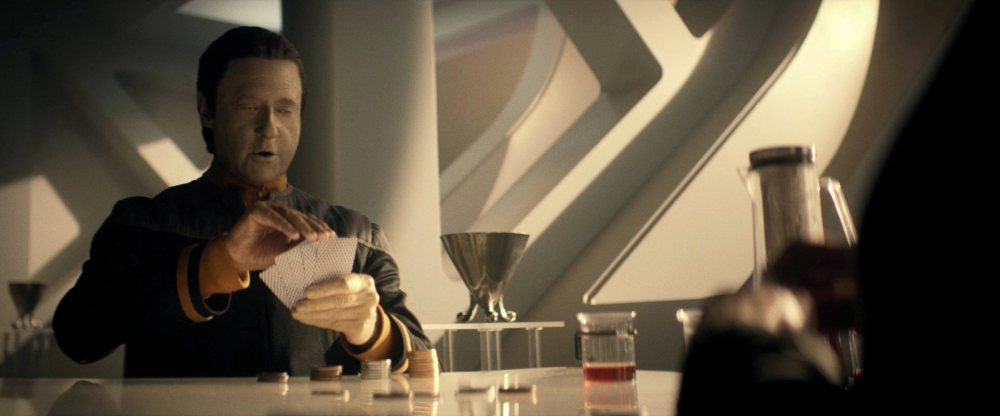 Jean Luc Picard, the world’s most British Frenchman, last appeared on our screens in the somewhat flagging movie Star Trek: Nemesis, in 2002, the fourth theatrical release to focus on Picard and his crew from Star Trek: The Next Generation, that ran for seven very successful years from September 1987 to May 1994, and brought in a new host of fans to televised adventures set a century after those of the popular (if hammy) Captain Kirk. Picard was joined on his travels by characters like Commander Riker (Jonathan Frakes) pop psychiatrist/counsellor Deanna Troi (Marina Sirtis) and most memorably, the android Data (Brent Spiner) a white skinned, yellow-eyed modern Pinocchio, looking to become more human in his explorations of social life and culture – and to who Picard became a mentor and advocate.
Jean Luc Picard, the world’s most British Frenchman, last appeared on our screens in the somewhat flagging movie Star Trek: Nemesis, in 2002, the fourth theatrical release to focus on Picard and his crew from Star Trek: The Next Generation, that ran for seven very successful years from September 1987 to May 1994, and brought in a new host of fans to televised adventures set a century after those of the popular (if hammy) Captain Kirk. Picard was joined on his travels by characters like Commander Riker (Jonathan Frakes) pop psychiatrist/counsellor Deanna Troi (Marina Sirtis) and most memorably, the android Data (Brent Spiner) a white skinned, yellow-eyed modern Pinocchio, looking to become more human in his explorations of social life and culture – and to who Picard became a mentor and advocate.
After losing one Enterprise and gaining another ship, the crew continued into movie installments, briefly crossing over with Kirk (William Shatner) until all came to an abrupt halt in 2002 with Star Trek Nemesis, directed by Stuart Baird. At the time, Brent Spiner was concerned that he was aging a good deal, and would not be able to keep on satisfyingly depicting an android who hardly aged. So with his permission, the end of the film featured Data sacrificing himself to rescue Picard from a dangerous adversary, and a plot connected to the scheming Romulans (often second fiddle adversaries to the cornish-pasty headed Klingons, TV’s favourite space Vikings). The film ended with several of the old cast preparing to part ways onto new things, with Riker promoted to a captain and married to Troi, leaving a sequel tentative at best. As it happened, Patrick Stewart felt he was done with the character of Picard, and moved on to other roles, notably as Professor Xavier in the X-Men movies, and a return to stage roles. Brent Spiner made a fleeting appearance in the rather dud sequel to Independence Day in 2016, and Jonathan Frakes continued a career as a director.
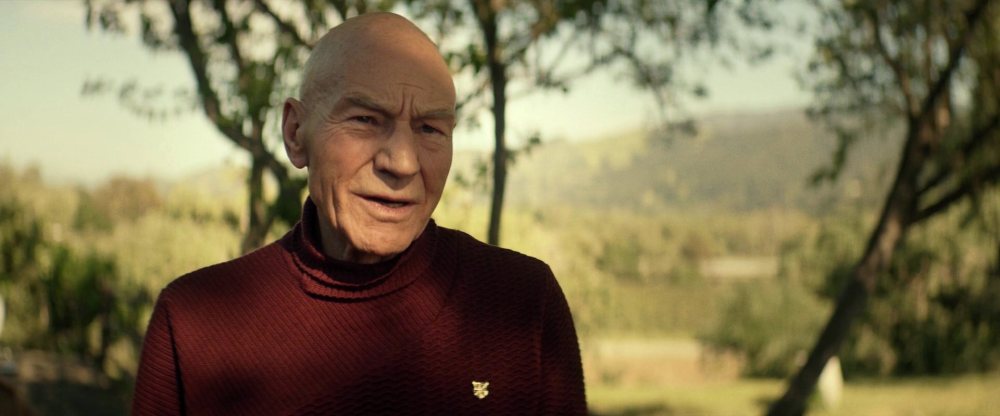 So what changed? In fandom, and the franchise, rather a lot, as the rights to Star Trek got split up between Paramount studios and CBS Entertainment Group, and their channel. Paramount released new movies following a recast Kirk and crew in a new timeline, whilst CBS was not allowed to use the same characters, and for a time was headed by Les Moonves – a producer with little interest in conventional science fiction television. His fall from grace, amidst allegations of sexual misconduct, got the ball rolling on new projects, beginning with Star Trek Discovery, released in 2017. The new show contained controversial elements like a nearly total visual reboot of style, and a redesign of the Klingons, despite it also being a prequel show that added new backstory to characters like Spock (in the form of a previously unknown adopted sister) and other elements that enjoyed mixed reception from fans. It is currently awaiting the release of a third season. During this same period, plans were drawn up for further Trek television projects, most anticipated, a return to the era of Next Generation, Deep Space 9 and Voyager – and was as later revealed, to the character of Jean Luc Picard himself. Teased as a mini series, the show was to focus on a retired Picard drawn out of a slump and into a new mystery that would personally engage him, with the possibility of other classic Trek characters showing up further down the line. Stewart himself was persuaded to reprise the role with the promise the character would be a very different place, be allowed to evolve, and that the show would be ‘more adult’ as well as more political. Feeling disgruntled over recent issues with Donald Trump, the refugee crisis in Syria and elsewhere and (if we dare invoke it’s name) Brexit, Stewart agreed. And so the show was put out for released on CBS All Access, one of the prolific US ‘streaming services’ now common to TV and internet, with limited free access initially.
So what changed? In fandom, and the franchise, rather a lot, as the rights to Star Trek got split up between Paramount studios and CBS Entertainment Group, and their channel. Paramount released new movies following a recast Kirk and crew in a new timeline, whilst CBS was not allowed to use the same characters, and for a time was headed by Les Moonves – a producer with little interest in conventional science fiction television. His fall from grace, amidst allegations of sexual misconduct, got the ball rolling on new projects, beginning with Star Trek Discovery, released in 2017. The new show contained controversial elements like a nearly total visual reboot of style, and a redesign of the Klingons, despite it also being a prequel show that added new backstory to characters like Spock (in the form of a previously unknown adopted sister) and other elements that enjoyed mixed reception from fans. It is currently awaiting the release of a third season. During this same period, plans were drawn up for further Trek television projects, most anticipated, a return to the era of Next Generation, Deep Space 9 and Voyager – and was as later revealed, to the character of Jean Luc Picard himself. Teased as a mini series, the show was to focus on a retired Picard drawn out of a slump and into a new mystery that would personally engage him, with the possibility of other classic Trek characters showing up further down the line. Stewart himself was persuaded to reprise the role with the promise the character would be a very different place, be allowed to evolve, and that the show would be ‘more adult’ as well as more political. Feeling disgruntled over recent issues with Donald Trump, the refugee crisis in Syria and elsewhere and (if we dare invoke it’s name) Brexit, Stewart agreed. And so the show was put out for released on CBS All Access, one of the prolific US ‘streaming services’ now common to TV and internet, with limited free access initially.
As for the politics, much of this ends up playing into the show’s overall plot, a result actually somewhat shocking, and even disheartening, for many Star Trek fans. Set twenty years after the movie Star Trek Nemesis, we open, in the first episode ‘Remembrance’, on a crotchety, somewhat embittered Picard trying to avoid an interview with the Federation News Network, to ask him about his career, and why he resigned from Starfleet fourteen years ago. Picard has been living on his ancestral vineyard and chateaux in La Barre region, eastern France, close to Switzerland (though the actual locations are filmed at sunny California) and is being tended to by two Romulan refugees who owe him a debt for saving him. Details are slowly revealed across the first episode or two, as to how Picard, and the galaxy as a whole, has changed. Beginning with the inciting event of a supernova (first established in the 2009 movie directed by J J Abrams) that threatens to destroy the home of the Federation’s old enemies, the Romulans, it led to a chain of events that demoralized Earth and Starfleet, and a turn towards isolationism and pessimism, within the Federation. Quickly losing his temper with the female interviewer, Picard snaps out that he left the service because it ‘was no longer Starfleet’, and that they had come to abandon their principles, to his eyes. More is revealed in a flashback during episode 2, showing a mysterious terror attack on Mars and it’s shipyards, later connected to Synths, a new race of android labourers patterned after Data, though supposedly non sentient. Their assumed revolt not only destroyed much of a fleet needed for refugee relief work, but also turned much of the known galaxy against androids altogether, further disheartening Picard, and his still fond memories of Data.
The end result saw an already wary Federation largely turn it’s back upon the Romulans, a past adversary, who’s own draconian government refused to take the threat fully seriously, and later saw their homeworld destroyed and many forced into camps or struggling colonies, still reliant on outsider help. Although it all has some major resonance with current real world politics, it is all a far cry from the idealism of Star Trek Gene Roddenbury and later show runners like Rick Berman – and is a tough pill for many long term fans to swallow. Picard is stirred out of his isolation by a cry for help from a runaway adolescent named Dahj (Isa Briones) who is later blown up in front of his eyes. From listening to her, he suspects she was a new form of android, and learns from a Doctor Agnes Jurati (Alison Pill) who worked on former android projects, that it is possible she has a twin. Picard suspects there may be an entire colony of androids in hiding, and learns from his Romulan housekeeper Laris (Orla Brady, in the role of apparently the most Irish-accented Romulan of all time) that the androids may be being hunted by a fanatical Romulan cult with a deep rooted hatred of artificial life. It is an effective enough ‘hook’ for the show, though somewhat clunky. Much is promised from the initial set up, including a look at what it means to be a living being, what makes somebody count as ‘human’ and if the Federation can transcend it’s new timidity and distrust. Only some of this is answered by the end of the initial ten episodes, though, with a second season of episodes so far greenlit.
It is not til the end of episode three of the show (‘The End is the Beginning’) that Picard and a misfit band of travelers actually board a ship in search of the androids. And this is after a disconcerting discussion with Starfleet’s commanding Admiral, Clancy (Ann Magnusson) that sees her lose her temper with Picard’s apparent conspiracy theories and past disrespect of her, that she drops multiple f-bombs into the conversation (swearing having previously shown up in Star Trek Discovery, not so long ago) This is another concession to adult themes in the shown, although comes off leaving a bit of a bad taste in the mouth. Added to that is the issue that Star Trek is no longer a family show, but following the footsteps of other adult dramas now often found on ‘streaming services’. Violence also periodically peppers the show, including some unpleasant deaths, several Romulan suicides, and a (admittedly tasteful) beheading. Dahj’s upsetting immolation in an explosion is contrasted with a still living twin sister named Soji, who is studying rehabilitated Borg and Borg technology, aboard a derelict Borg Cube, with Romulans and other scientists. The nightmarish, zombie like villains of prior Next Generation episodes play an only small tangent role in the story, as it is later revealed the same conspiracy against androids is also funding this project, and hoping to turn the Borg drones to their own ends. Soji is charmed and subtly manipulated by a handsome Romulan named Narek (Harry Treadaway) who is in turned being watched by a Romulan agent named Narissa (Peyton List) who refers to herself as his ‘sister’, whilst being uncomfortably flirtatious.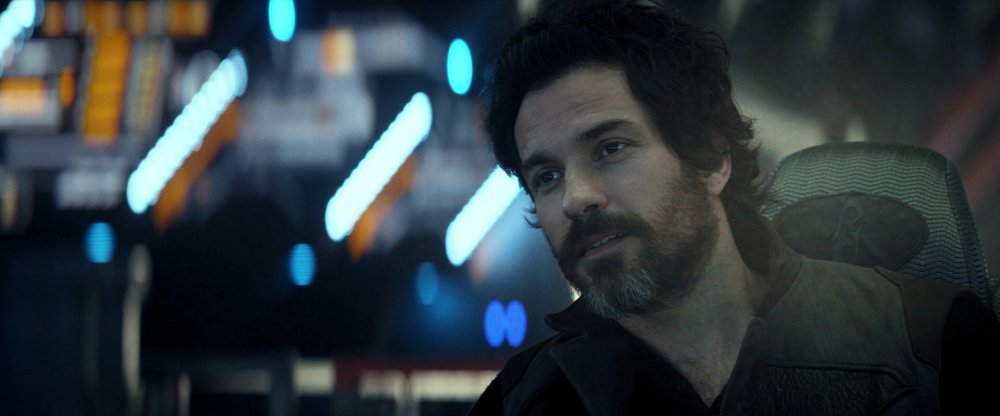
Picard meanwhile, turned down for official Starfleet help, decides not to involve his other old friends like Riker or Geordi (LeVar Burton, so far unseen in the show) and instead approaches retired Starfleet captain Raffi Musiker (Michelle Hurd) who previously worked with Picard during his time as an Admiral, but has now become a drop out with implied substance abuse, and estrangement from her son. Picard also recruits the charismatic but impious Christobal Rios (Santiago Cabrera, pictured) a former Starfleet officer who now runs his own civilian ship, the La Sirena. Both are played by decent actors, although Raffi remains a cipher for much of the initial episodes, and displays a familiarity with Picard that feels unearned to those seeing her for the first time. Rios emerges as more of a dark horse, damaged like Raffi, but far more charismatic, affecting a laid back and occasionally flirtatious attitude, and staffing his ship with eccentric hologram versions of himself, sporting various exaggerated accents. He is maybe an acquired taste, but adds some life to an often very emotionally stilted series, thus far. Alison Pill plays Jurati as a nervous but still enthusiastic newcomer to space travel, but who turns out to hold a darker secret beneath it all. Later on they are joined by Elnor (Evan Engora) a Romulan warrior monk figure, who feels so far a little too much like a carbon copy of Legolas from the Lord of the Rings films, but has begun to show signs of deeper quirks and principles.
On their way to a sort of space Las Vegas/Atlantic City called Freecloud, in search of Dahj’s suspected creator, Bruce Maddox, they take on Elnor, confronting paranoid and racist Romulans, and sparking a fight that leads to an almost gratuitous beheading, in order to show off Elnor’s skills. A run in in space with a pirate vessel sees them joined by another ally, former Borg drone Seven of Nine (Jeri Ryan, looking to have barely aged since her days on Star Trek Voyager) aka Annika Hansen. Seven has also left Starfleet, and now works as a kind of vigilante, hunting down those who deal in black market stolen technology, including from other ex-Borg. The murder of one close friend in particular has sent her down a darker, more vengeful path, that reaches a head at Freecloud. Ryan acquits herself well in her return to her iconic role (albeit without the infamous catsuit the Voyager showrunners clad her in! Instead opting for a sensible jacket combo) Seven disappears after episode 5 (quirkily titled ‘Stardust City Tag’) only to return around the finale period, being so far a crucial, but still peripheral, guest star. The way the final episode played out may change this for any role she has in season two, however.
After their rescue of Doctor Maddox (John Ales) turns awry, Picard is later able to locate Soji aboard the Borg cube seen earlier, and is reunited with Hugh (Jonathan Del Arco) a young man he rescued from the Borg years earlier. After a fairly traumatic flashback to Picard’s own time among the Borg, they bond and commiserate over old times. Soon forced to flee from Romulan agents, they make use of a Borg gateway (based on technology briefly seen in a Voyager episode named ‘Prime Factors’) and use it to escape, whilst Hugh and Elnor stay behind to buy time. This leads in to the breather episode, ‘Nepenthe’, set on the titular planet, named for a Greek drug of forgetfulness. Seeking sanctuary here finds Picard and his new ward meeting up with Will Riker and his wife Deanna Troi, now retired, having moved to the peaceful world during a prior family crisis. Whilst a somewhat contrived way to bring them into the story, it is still satisfying to see more familiar faces as part of the series, and to see them and Picard talk about old times, somewhat. Riker also gets to indulge his culinary side in cooking pizza and sausages (mad from local, venomous rabbit-style creatures) There is also a brief look at their family life, though like much else in Picard – the series, there is a more bitter side to things as well.
Meeting up with Rios and Raffi again, the journey continues, culminating at a world called Coppelius, where all the characters converge, meeting up with a community of sophisticated androids that Soji has hidden memories of. Here the audience receives another surprise cameo of Brent Spiner, playing Doctor Alton Inigo Soong – the hitherto unseen son of Data’s creator, who has been teaching the various androids, as well as trying to construct new bodies. Spiner has aged well, though with the expected greying hair, and if this was to be Data’s new body, I don’t think many would have complained that much. Still, that is not the direction the show goes with the character (but nor is it the last word on him, either)
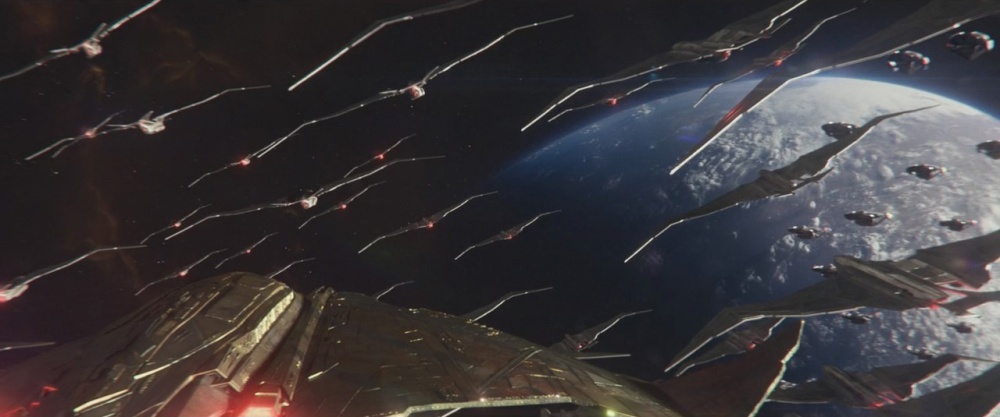 It is soon learned that a Romulan fleet is on the way to the planet though, led by the treacherous Commodore Oh (Tamlyn Tomita) a deep cover agent within the Federation – and now bent on exterminating all the androids. With discord being sown among the androids by Narek (beginning to have second thoughts) the stage is set for the finale to unfurl.
It is soon learned that a Romulan fleet is on the way to the planet though, led by the treacherous Commodore Oh (Tamlyn Tomita) a deep cover agent within the Federation – and now bent on exterminating all the androids. With discord being sown among the androids by Narek (beginning to have second thoughts) the stage is set for the finale to unfurl.
To summarize, the show has presented decent enough characters and visuals – the actual script and dialogue has been fair to middling at best, often. Commodore Oh, Narissa and other villains often have pretty poor dialogue (although Narissa manages to have the most fun in the delivery of it). Ideas are examined, but often not in the fullest depth they could have been. This becomes notable as well during the finale, in particular. Hanging over the plot is a secret uncovered by the Zhat Vash conspirators, of some kind of ancient race promising extinction to those that create and mistreat sentient androids: not a lot is made of this topic, except for a very brief appearance during the finale. In concept it ends up seeming like a partial rip off of the Mass Effect videogames and their infamous Reapers. If we ever revisit this race, I hope there is more depth shown about them. As for the rest of this review, I suggest that you raise shields to prepare for…
SPOILERS INCOMING
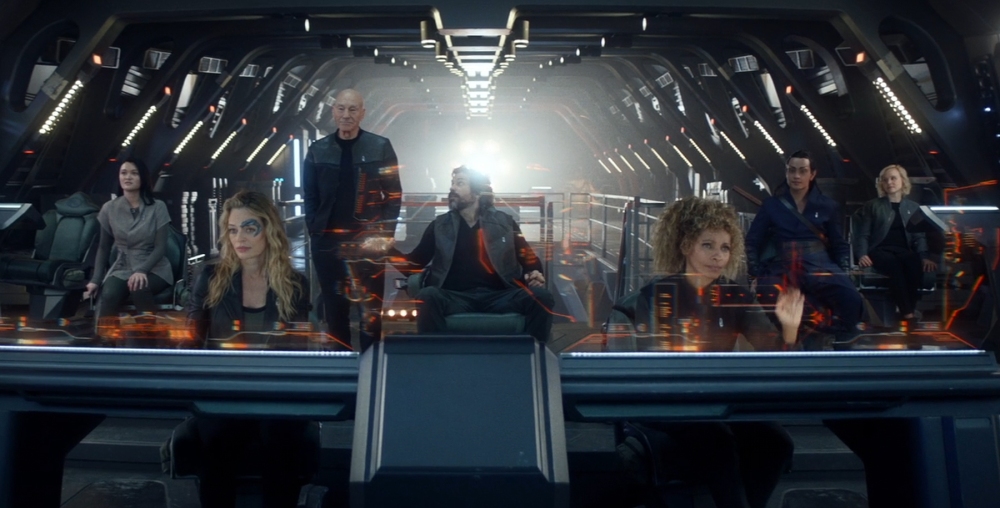
The ending of the first season manages to tie several things up, but not exactly neatly, and feels a bit rushed, at times. Some characters are disposed of, including the untrustworthy new android Sutra (Isa Briones), who sides with Narek only to be killed off – and Narissa, who is given a good shove off a balcony by Seven of Nine, for killing Hugh earlier. Picard goes up to confront the Romulans, not expecting to survive, and aware he has a failing health situation as well. Thanks to a holographic decoy devive Jurati obtained, they are able to confuse the Romulan ships, long enough for Sohji to shut down the beacon Sutra and other androids were sending out, preventing the arrival of the mysterious ‘destroyers’ that the Romulans feared. And in a fan pleasing moment, Captain William Riker arrives with the new USS Zheng He and a bunch of copy pasted (and generally under-detailed) new CGI starships, to drive aware the bad guys. Picard’s efforts prove too much for him though, and he blacks out, seemingly dead.
He wakes up in what turns out to be a computer made quantum simulation, based on Picard’s own chateau (an interior re-used a lot this series, including in holodeck form) and is confronted with Data, restored to life inside the simulation from a fragment of his own neural network. They are able to have a heart to heart, where Data reveals he was glad enough to sacrifice himself for Picard, as he would have done for him. He also reveals that Picard has a chance to go back, and if he does, asks that he deactivate the simulation, as it is not really a full life, and ponders on the nature of mortality, somewhat. “A butterfly that lives forever, is not really a butterfly at all…” After this, Picard walks ‘into the light’ as it were, and wakes up, once more.
Foreshadowed a bit clumsily earlier, Picard finds himself within what Doctor Soong had termed a ‘golem’ – and android body suitable for uploading human minds into, one now made to look just like his original body. It’s even – somewhat bizarrely – programmed to age and even die, within his typically expected lifespan, just with no illnesses. This clears Picard of his mental condition (the Irumodic syndrome, first hinted at back in Next Generation’s own finale “All Good Things”) but does not really confer him any other major advantages or changes. The main point seems to have been so Picard can (very briefly) sacrifice himself, and also to meet up with Data in a kind of ‘limbo’ and thus obtain emotional closure (as to some extent, can the audience, if they are receptive to such) Little else is affected, nor will Picard become super strong or advanced, and thus it will (thus far) appear to have little impact on the future storylines whatsoever. Additionally, the whole earlier plotline of the Federation banning research into androids is resolved offscreen in the end of the episode, with the ban suddenly lifted. Though it is nice to see the Federation finding it’s way back towards it’s more optimistic and open minded old ways, this does feel cheap and unearned, and the call for a debate and council session to lift the ban could have been an interesting issue to put into the first part of the now confirmed second series of the show. Much more could have been made of issues like artificial intelligence, personal rights/equal rights, what it means to be human, and other old science fiction staples. Instead, the focus seems to switch back to the characters going forward, and with Data now pretty much confirmed to stay dead – a bit of a disappointment for many fans. Picard does movingly send him off by switching off the simulation and glimpsing Data in his final moments, saying “We are such stuff as dreams are made of, and our little life, is rounded by a sleep” – appropriately, for an old Shakespearean. Riker also does not appear for that long, nor other supporting characters – though there is room to revisit them, now.
So we again receive something of a mixed bag, for old Star Trek fans, and an attempt to drawn in new ones – but one leaning just a bit too far into the dark and grimmer mood and settings than I feel that comfortable with. The episode “Stardust City Rag” particularly opens in a nasty way that leaves a bit of a bad taste in the mouth, and some fairly nasty violence and shock value scenes are often left in. I can only hope this opens the doors towards a transition to more of the older, gentler Star Trek we are used to, with some more story, topical and character depth – as well as fewer F-bombs, quite frankly. Visually, the show looks crisp and professional, but the lighting can be a bit limited, moody or samey, and the camera work a bit rapid or rushed. Other times it does focus for longer on character moments and quieter scenes, allowing a bit more balance. The characters remain uneven, in many cases, particularly the villains, with only Narek and Narissa standing out very much, and Narek gets some pretty corny scenes with Soji earlier on. Brent Spiner makes the most of his few scenes, including a nostalgic dream sequence at the start of the series, involving an old poker game with Picard. Jonathan Frakes has fun with his scenes, including trash talking an enemy commander. As Seven of Nine, Jeri Ryan acquits herself well, but is still scripted pretty generically, with much angst, and little of her old reserve and sardonism. The star of the show, and generally dominating most major scenes, is Patrick Stewart himself as Picard, still able to showcase much of the character’s mix of stentorian commanding air and warmer, more approachable side, driven as ever by ideals and high standards. And for a decade as confused and divided as this one has been, that cannot really be a bad thing.
I just hope that future episodes can branch out a bit more, and particularly, lighten UP – as that too, is badly needed these days. Being written as effectively a single ten hour storyline with some minor subplots gives the material little room to diverge or diversify, and I hope this is partially addressed, next time around. For now, taken as a character focused and pretty serialized show, this is a decent outing. In effect, it is Star Trek, Jim, just not quite as we know it – and let’s hope it can live long and prosper further…
A few word choices and spelling mistakes I will need to revise at some point, here, but otherwise, not a bad post.
LikeLike